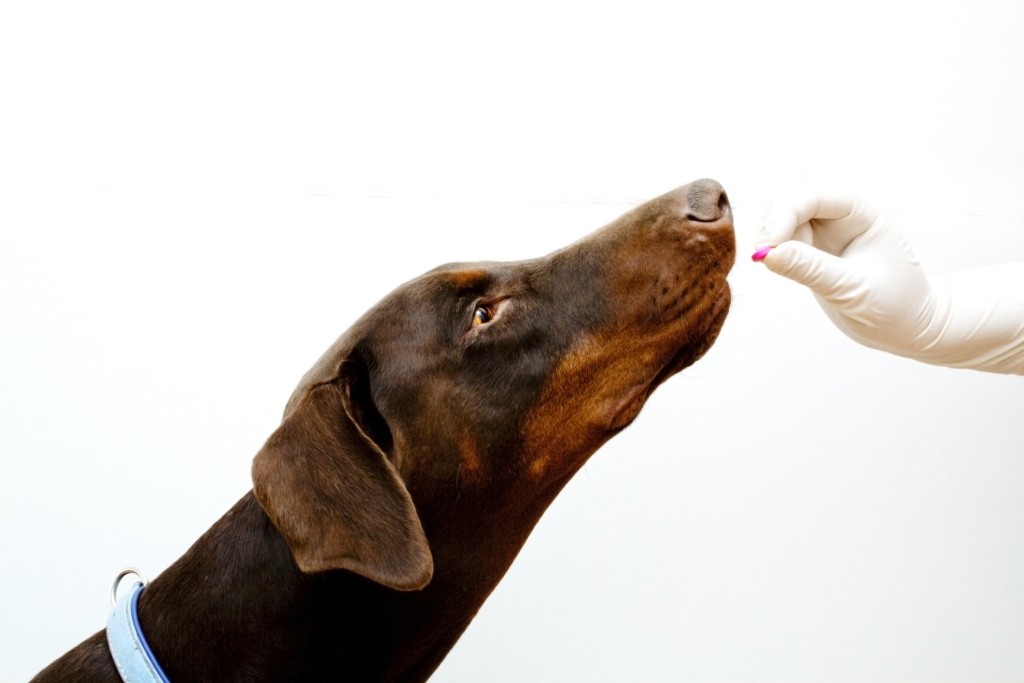Dogs are curious and energetic, so it’s inevitable that some of them will wind up in some sticky situations. From running through some poison ivy to getting stung by a bee, there are plenty of problems that can lead to your dog feeling itchy, uncomfortable, and swollen from an allergic reaction.
Your dog doesn’t need to suffer, though. With a vet’s guidance, you can use diphenhydramine (Benadryl) to ease the worst of their allergy symptoms. Here’s how Benadryl can be given to dogs safely.
Benadryl, or diphenhydramine, is an antihistamine that helps relieve the symptoms of allergies in both humans and animals. It can also be used to relieve the symptoms of motion sickness if a dog needs to be transported long distances. For most dogs, the appropriate dosage of Benadryl is perfectly safe. It will begin to reduce symptoms like skin rashes in about an hour.
Getting the dosage right is important because most Benadryl tablets are intended for humans. Some dogs can be quite small, so they need less Benadryl than a person. Dogs also metabolize Benadryl differently, so it’s not a good idea to rely on human dosing guidelines.
Benadryl dosage for dogs. The correct dosage of diphenhydramine for dogs depends on their weight. A small dog will need much less than a big dog to receive the same positive effects. According to the Merck Veterinary Manual, the safe dosage is 2-4 milligrams of medication per kilogram of weight, or 0.9 to 1.8 milligrams per pound. This amount can be administered two to three times daily, depending on your dog’s symptoms.
While it’s best to use vet-approved Benadryl tablets or ointments, in some cases it is possible to use tablets intended for humans. If you choose to do this, keep these things in mind:
Risks of Benadryl for dogs. While the right dose of Benadryl is safe for most dogs, occasionally a dog may be allergic to the medication itself. An allergy to diphenhydramine will have similar symptoms to other allergies, including:
Almost all symptoms due to medication will be noticeable during the first hour after consuming the substance, so keep an eye on your dog for any changes in behavior. Dogs may also experience a number of more common, less dangerous side effects to Benadryl, like:
Benadryl overdose. Ignoring any of these guidelines can lead to an overdose of diphenhydramine, with symptoms ranging from seizures to respiratory failure to a coma, depending on the size of the overdose. If you believe your dog has overdosed on Benadryl, contact your vet immediately and follow their instructions for emergency treatment.
Alternatives to Benadryl for dogs. If your dog reacts poorly to Benadryl but needs regular allergy treatment for a seasonal allergy, there are some alternatives you can use. Both cetirizine (Zyrtec) and loratadine (Claritin) are considered safe for dogs in the right dosage. However, they are also frequently combined with other ingredients like decongestants, which can hurt your dog. Always consult with a vet before giving your dog any new medication.
For acute allergic reactions, it’s better to use faster-acting methods of reducing itching, such as cortisone creams or shots. These treatments begin to work in minutes. However, cortisone treatments are best for short-term use and may lead to uncomfortable side effects for your pet.
When to call your vet. In an emergency, you should always call your vet first. Your dog may experience anaphylactic shock from their allergies, or in rare cases, from Benadryl itself. Call the vet immediately if your dog is:
These may be signs of a serious allergic response that needs immediate treatment. Similarly, if your dog has been bitten by a snake or stung by an unfamiliar insect, call your vet immediately to ensure your dog has not been poisoned.
Therefore, a simple and practical dose is 1 mg of Benadryl per pound of your dog’s weight, given 2-3 times a day. For example, a 10-pound dog might receive a 10 mg dose in the morning, afternoon, and evening.
How do I count the Benadryl dose for dogs?
To count the Benadryl dose for dogs, you should:
Get rates for your pet:See My Rates »

Last updated Feb. 15, 2022. Reviewed for accuracy on Dec. 11, 2019 by JoAnna Pendergrass, DVM
Benadryl is not yet FDA-approved for veterinary use, but it is generally considered safe for use in dogs with mild-to-moderate allergies. Benadryl is a brand name for an antihistamine (diphenhydramine HCl) that can help alleviate symptoms of allergic reactions and even anxiety. Histamine is a substance released by mast cells (a type of immune cell) and is responsible for inflammation and other allergy symptoms. The active ingredient in Benadryl is diphenhydramine, which works by blocking histamine receptors on a cell’s surface, meaning that the receptors cannot ‘accept’ histamine that tries to attach and trigger an allergic reaction.
Symptoms of allergic reactions that can be treated with Benadryl include hives, swelling, and itching. Severe reactions, like anaphylaxis, can be life-threatening and should be treated by a veterinarian (who may give an injection of diphenhydramine along with other emergency injections).
Many veterinarians approve Benadryl for home use as a regular go-to treatment. It may be suitable for:
Uses of Benadryl for dogs
Benadryl, or diphenhydramine, is a common over-the-counter medication that helps relieve itching, swelling, and other allergy symptoms.
Because of this, you can give it to your dog for conditions like:
- Swelling
- Hives
- Sneezing
- Runny nose and eyes
- Itchy skin
FAQ
How much Benadryl can I give my 6lb dog?
Will Benadryl make my dog sleepy?
How many mg is 5 ml of Benadryl?
How much Benadryl can a 5lb dog have?